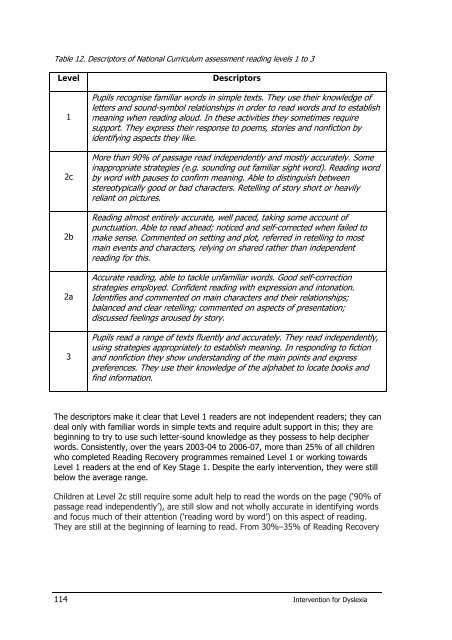Intervention for Dyslexia - The British Dyslexia Association
Intervention for Dyslexia - The British Dyslexia Association
Intervention for Dyslexia - The British Dyslexia Association
Create successful ePaper yourself
Turn your PDF publications into a flip-book with our unique Google optimized e-Paper software.
Table 12. Descriptors of National Curriculum assessment reading levels 1 to 3<br />
Level Descriptors<br />
1<br />
2c<br />
2b<br />
2a<br />
3<br />
Pupils recognise familiar words in simple texts. <strong>The</strong>y use their knowledge of<br />
letters and sound-symbol relationships in order to read words and to establish<br />
meaning when reading aloud. In these activities they sometimes require<br />
support. <strong>The</strong>y express their response to poems, stories and nonfiction by<br />
identifying aspects they like.<br />
More than 90% of passage read independently and mostly accurately. Some<br />
inappropriate strategies (e.g. sounding out familiar sight word). Reading word<br />
by word with pauses to confirm meaning. Able to distinguish between<br />
stereotypically good or bad characters. Retelling of story short or heavily<br />
reliant on pictures.<br />
Reading almost entirely accurate, well paced, taking some account of<br />
punctuation. Able to read ahead; noticed and self-corrected when failed to<br />
make sense. Commented on setting and plot, referred in retelling to most<br />
main events and characters, relying on shared rather than independent<br />
reading <strong>for</strong> this.<br />
Accurate reading, able to tackle unfamiliar words. Good self-correction<br />
strategies employed. Confident reading with expression and intonation.<br />
Identifies and commented on main characters and their relationships;<br />
balanced and clear retelling; commented on aspects of presentation;<br />
discussed feelings aroused by story.<br />
Pupils read a range of texts fluently and accurately. <strong>The</strong>y read independently,<br />
using strategies appropriately to establish meaning. In responding to fiction<br />
and nonfiction they show understanding of the main points and express<br />
preferences. <strong>The</strong>y use their knowledge of the alphabet to locate books and<br />
find in<strong>for</strong>mation.<br />
<strong>The</strong> descriptors make it clear that Level 1 readers are not independent readers; they can<br />
deal only with familiar words in simple texts and require adult support in this; they are<br />
beginning to try to use such letter-sound knowledge as they possess to help decipher<br />
words. Consistently, over the years 2003-04 to 2006-07, more than 25% of all children<br />
who completed Reading Recovery programmes remained Level 1 or working towards<br />
Level 1 readers at the end of Key Stage 1. Despite the early intervention, they were still<br />
below the average range.<br />
Children at Level 2c still require some adult help to read the words on the page (‘90% of<br />
passage read independently’), are still slow and not wholly accurate in identifying words<br />
and focus much of their attention (‘reading word by word’) on this aspect of reading.<br />
<strong>The</strong>y are still at the beginning of learning to read. From 30%–35% of Reading Recovery<br />
114 <strong>Intervention</strong> <strong>for</strong> <strong>Dyslexia</strong>









